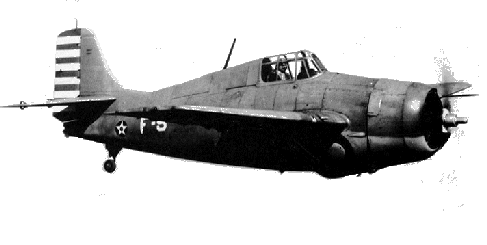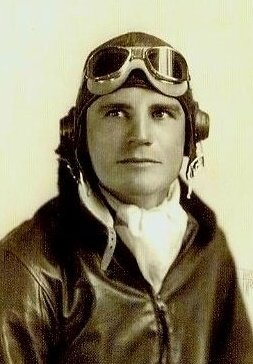 Howard Reason Burnett, Lieutenant, U.S. Navy, 0-104595, United States Naval Reserve. Entered the service from Kansas. Finding of death: August 5, 1945. Missing in Action or Buried at Sea. Tablets of the Missing at Honolulu Memorial , Honolulu, Hawaii. Awards: Silver Star, Air Medal with Gold Star, Purple Heart. (ABMC)
Howard Reason Burnett, Lieutenant, U.S. Navy, 0-104595, United States Naval Reserve. Entered the service from Kansas. Finding of death: August 5, 1945. Missing in Action or Buried at Sea. Tablets of the Missing at Honolulu Memorial , Honolulu, Hawaii. Awards: Silver Star, Air Medal with Gold Star, Purple Heart. (ABMC)
At right: Lt. Howard Reason Burnett, U.S.N. Photo courtesy of Addie Ellen (Burnett) Thomison.
USS Enterprise, CV-6, War Diary, August 24, 1942: (Eastern Solomons) G.C.T. - 0147; L.C.T. 1317 : "Launched three VSB (Flight 327).
Mission: Inner Air Patrol for Task Force 11.
Action: Carried out mission. 6-S-15, Ensign H.R. BURNETT, pilot, was returning just prior to JAP attack. He attacked dive-bombers recovering from their dive near his position 6 miles NW of the ship and shot down one dive-bomber about 1715 using fixed guns. Landed all planes at 1827.
August 24, 1942 - The Battle of the Eastern Solomons: "Generally speaking, the SBD's - Douglas SBD Dauntless (Scout/Dive Bomber) - on patrol when the Japanese air attack materialized flew out of range of our antiaircraft fire and waited until the action was over before returning to land. However, several of these planes took part in the air fighting. Ens. Howard R. Burnett, observing the direction of the enemy planes' dives, flew his SBD into the path of their retirement, and attacked several with his two fixed guns. At 1715 he shot down an Aichi type 99 dive bomber." - Source: http://www.ibiblio.org/hyperwar/USN/USN-CN-ESols/USN-CN-ESolomons-4.html.
USS Enterprise, CV-6, War Diary, October 26, 1942: G.C.T. L.C.T. 1750 0550 Went to General Quarters. 1812 0612 Established Combat Patrol (7 VF). Recovered at 0910. 1819 0619 Launched Dawn Scouting Flight (16 VSB to search sector 235� T. - 000� T., distance 200 miles. Armament: One 500 lb. bomb and M.G. ammunition. Contact Reports sent to ENTERPRISE at 0730, 2 BB, 1 CA, 7 DD at lat. 08� 10' S., long. 163� 55' E., course north, speed 20 knots. Followed by amplifying report "Course west, speed 25." At 0750 report received from our search planes "2 CV's and accompanying vessels in lat. 07� 05' S., long. 163� 38' E." Damage to Enemy: Two 500 lb. bomb hits on a carrier of the SHOKAKU class by Lt. S.B. Strong and Ensign C. B. Irvine, one probable hit with 500 lb. bomb on an unidentified cruiser by Lt.(jg) H.R. Burnett. Seven Zeros were shot down by the following: Lt.Comdr. J.R. Lee, Lt.(jg) W.E. Johnson (2), CARLOW, C.H., A.R.M.1c., WILLIAMS, GARTNER, N., Jr., one Mitsubishi 97 Torpedo bomber was shot down by Lt.(jg) H.R. Burnett. Landed - 1031 - 1048." (This day's events became known as The Battle of Santa Cruz Islands.)
RESULTS OF ENTERPRISE AIR SEARCH, 26 OCTOBER 1942:
"Ens. Howard R. Burnett and Ens. Kenneth B. Miller, searching subsector 282�-298�, climbed to 14,000 feet upon receiving an unspecified contact report and attacked a Japanese cruiser. The results were undetermined, although a fire on the stern of a cruiser was later reported by the Enterprise attack group. Before attacking, Ens. Burnett sent the Enterprise a report of the ships sighted. Furious antiaircraft fire was experienced during the bombing dive. It was so effectively directed that the concussions "caused [the plane] to spin approximately 4,000 feet before it could be brought under control and the dive reentered." Neither of these aircraft met fighter opposition, and both returned safely to the Enterprise. Ens. Burnett joined one of the combat air patrols endeavoring to protect the Hornet and shot down one enemy plane." --Source: http://www.ibiblio.org/hyperwar/USN/USN-CN-SantaCruz/USN-CN-SantaCruz-5.html.
During the Battle of Guadalcanal, Lt.jg. H.R. Burnett was a member of Scouting Squadron Ten (VS-10), which was part of The Cactus Air Force. VS-10 was part of Carrier Air Group One which was based on the U.S.S. Enterprise, and on Henderson Field Nov. 13-16.
Ensign H.R. Burnett is mentioned on page 95 of The Struggle for Guadalcanal: August 1942-February 1943 (History of United States Naval Operations in World War II, Volume 5) . View photo of a Grumann Wildcat
 A photo of Scouting Squadron Five (VS-5) taken on board the U.S.S. Enterprise in July of 1942 just before the Guadalcanal Campaign includes an Ensign Burnett who resembles, and may have been, Ensign H.R. Burnett.
A photo of Scouting Squadron Five (VS-5) taken on board the U.S.S. Enterprise in July of 1942 just before the Guadalcanal Campaign includes an Ensign Burnett who resembles, and may have been, Ensign H.R. Burnett.
"My brother, Howard Reason Burnett, attended KU. In 1940, he enlisted in the U.S. Naval Reserve. Lieutenant Burnett was awarded two Presidential Unit Citations, and Air Medal, a Gold Star, the Silver Star and the Purple Heart while assigned to the USS Enterprise, the First Marine Division, Reinforced, and to the USS Lexington as Division Leader of an Air Group. The Grumman Hellcat in which he was flying was hit by anti-aircraft fire and crashed in flames on Iwo Jima, Volcano Islands, on August 4, 1944." -- Ellen Burnett Thomison, (CCH, p. 293).
August 4, 1944 : "In the Volcano Islands... A group from Task Force 38 (Admiral Clark) attacks Japanese positions on the island of Iwo Jima causing substantial damage."
18-21 JUL 1944 FIRST COMBAT MISSIONS - AGAINST GUAM
GRIFFIN, W: "We picked up the Lex near Ulithi on our way to the "real war"--no more practice dives or mock attacks, from here on out it was for real! My first combat strike against the Japanese was on 18 July, bombing a large airport on Guam. Needless to say, it was quite a thrill, until I saw one of our fighter pilots in an F6F get blown up into a huge ball of fire off to my left as I pulled out of my dive. The real impact came when I returned to the ship and found out it was "Redbird" Burnette, a handsome Lt. with whom I had played poker the night before. Since it was our first combat mission, the ship's doctor authorized issue of a 2 oz. bottle of whiskey (Old Overholt Rye) to each person who had gone off on a strike. I thought that was great until I belted it down in two gulps and a minute later lost the whole thing! That was the last time I drank any Old Overholt Rye--I offered my future shares to my gunner, Eno Leaf--he refused to drink it also, so I gave them to our Ready Room pantry cook, "Buck", who was delighted. Buck, of course made sure I received special treatment in regard to food preparation thereafter." -- Source: The Voices of Bombing Nineteen (VB 19) ( The preceding account gives an obviously wrong date and place for Red Bird's death)
4-5 AUG 1944 STRIKES ON BONINS - KAZANS - IWO JIMA
SCOTT: "4 August - Bill Emerson was shot down and picked up by a standby submarine. Roy Majors and his gunner Albini were lost to enemy gun fire. Two VF (Red Bird Burnette and Bob Wakefield) were shot down and lost." -- Source: The Voices of Bombing Nineteen (VB 19)
August 4, 1944 - LEXINGTON CV16 WAR DIARY & DECK LOGS:
0939 - Launch 20, fighter sweep over IWO JIMA, & 4 SCAP #2.
0956 - Launch 32, Strike 3A.
1301 - Land 20 F6F, fighter sweep & SCAP #2.
1430 - Land strike 3A.
1522 - Launch 31, Strike 3C.
1618 - Land strike 3B.
1804 - Land strike 3C. Air Ops -Launch 102, Land 97, lost 4, TBM to CV
Source: http://cannon-lexington.com/Pages/Ships%20Diary1943-44.htm
Howard Reason Burnett was the son of Howard Reynolds Burnett (see Coldwater Rodeo, 1923) and Marjorie Gaylord. His paternal grandparents were Howard Reason Burnett and Almira Ella Jordan. His maternal grandparents were Oscar and Addie Gaylord. (ABMC, CCH, CCVM, DJHSP)
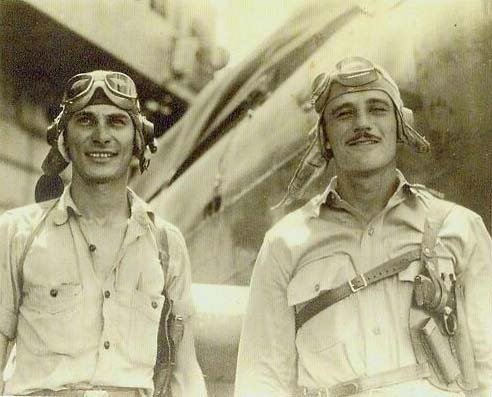
Lt. Howard Reason Burnett (with moustache), USN, stands at right in this photo of him with his gunner beside their dive bomber on an aircraft carrier.
Photo courtesy of Addie Ellen (Burnett) Thomison.
THE SECRETARY OF THE NAVY
WASHINGTON
4 February 1943
Cited in the Name of
The President of the United States
THE FIRST MARINE DIVISION, REINFORCED
Under command of
Major General Alexander Vandegrift, U.S.M.C.
CITATION:
"The officers and enlisted men of the First Marine Division, Reinforced, on August 7 to 9, 1942, demonstrated outstanding gallantry and determination against a number of strongly defended Japanese positions on Tulagi, Gavutu, Tanambogo, Florida and Guadalcanal, British Solomon Islands, completely routing all the enemy forces and siezing a most valuable base and airfield within the enemy zone of operations in the South Pacific Ocean. From the above period until 9 December 1942, this Reinforced Division not only held their strategic positions despite determined and repeated Japanese naval, air and land attacks, but by a series of offensive operations against strong enemy resistance drove the Japanese from the proximity of the airfield and inflicted great losses on them by land and air attacks. The courage and determination displayed in these operations were of an inspiring order.
Frank Knox
Secretary of the Navy.
View a facsimile of the Presidential Unit Citation (1st Marine Division, Reinforced)
The Western Star, March 12, 1943. LIEUT. H. R. BURNETT IS DECORATED by NAVY.
Coldwater Youth Deals Out Plenty to the Japs.
Lieutenant (junior grade), H. R. Burnett, son of Howard Burnett and Mrs. Marjorie Burnett of Coldwater, Comanche county's first naval aviation pilot to go into combat in the war theater, has been seeing a lot of action the past year.
In a letter to his mother dated February 6, from somewhere in the South Pacific, H. R. modestly stated: "they held a ceremony the other day and I was presented with a navy air medal for sinking a large cruiser." H. R. is piloting a Douglas "Dauntless" dive bomber, "Believe it or not," he wrote, "I had a few holes in my plane when I got back."
H. R. tells of a previous engagement with the Japs off Santa Cruz, as follows: "I went on a 200 mile search and found the Jap fleet of two battleships, two large cruisers, three light cruisers and seven destroyers. I turned in a contact report and dove on them, then got a hit on a cruiser, and coming back to the ship shot down one twin-engine bomber. I have decided those slant eyes just can't hit me. Guess I had better knock on wood. I really like it when we get into battle--that is the best part of all. It really gets exciting."
Lieut. Burnett, who grew up in the New Eden community east of Coldwater, attended Kansas University. After receiving his degree he was employed by ab electric company in Lawrence, Kans., and gave up a $200 a month job to enlist as a Naval Aviation Cadet in February, 1941. November of that year he received his "wings" and commission and in his class of 181 was first in aeronautical acrobatics. He left the United States last May and was stationed as a pilot on three airplane carriers which were sunk--the Lexington, Yorktown and Saratoga. He was on the carrier, Hornet also, shortly before it was sunk.
Few aviators have seen more combat than Lieut. Burnett, though he is now only 26 years of age. He is one of Comanche county's most daring and most capable young men.
* USS Hornet (CV-8) sunk after being torpedoed by Japanese aircraft during the Battle of Santa Cruz, Solomon Islands, 26 October 1942.
* USS Lexington (CV-2) sunk after being torpedoed by Japanese aircraft during the Battle of the Coral Sea, 8 May 1942.
* USS Yorktown (CV-5) damaged by aircraft bombs on 4 June 1942 during the Battle of Midway and sunk after being torpedoed by Japanese submarine I-168, 7 June 1942.
-- Source: http://www.history.navy.mil/faqs/faq82-1.htm
The Western Star, January 14, 1944.
LIEUT. H. R. BURNETT FEATURED on PROGRAM.
Was Interviewed by Phillip Morris' Ginny Simms.
One of America's No. 1. heroes, who is also Comanche county's No. 1. war
ace, was spotlighted in the top portion of a program over a nation wide
hook up Tuesday evening of this week when Lieut. (senior grade) Howard
R. Burnett of Coldwater was featured on the Ginny Simms Phillip Morris
program at 7:00 p.m., with a rebroadcast at 10:30 p.m. on a different chain.
Amid the fanfare and dive bomber sound affects of a Hollywood studio,
Johnny led off with "Ginny, they tell us out here about a most amazing
pilot: that if you want to meet a terrific guy, get hold of Red Bird.
There's a fighting bird for you! Johnny proudly presents Lieut. Howard
R. Burnett of the United States Navy."
In her interview with Lieut. Burnett, Ginny asked, "How did you get
that name, Red Bird?" "Well when I was in training I wanted action, but
it took too long, and it burned me out. But they gave me the bird
later." H. R. replied.
"Didn't you make a direct hit on a fuel dump at Guadalcanal and score a
hit on two Jap cruisers and get one jap plane?" asked Ginny. "I guess
that's right," replied H. R. He was asked why he changed over from a
dive bomber to a fighter pilot, to which the Coldwater flier responded:
"Well, you see, it was like this. I met five planes diving on my
carrier. I had a 500 pound bomb with me and couldn't get but one of the
Japs, as they outran me. I got sore and made up my mind I wanted to have
a fighter plane so I could 'wrap it up,' that is, kick it around pretty
fast. While I was up around New Caledonia one day I noticed some army
pilots stunting, so I tried some slow rolls in my dive bomber." "What
did your skipper say to that?" inquired Ginny. "He said, as a dive
bomber, you're a pretty good fighter," the lieutenant related.
H. R. relinquished his call home to give time for the important message
broadcast to all high school graduates and Seniors who are 17 years of
age. "Six thousand of you are needed for V-5 training to become pilots
and ensigns in the Navy or second lieutenants in the Marine Corps." To
which Ginny added: "How would you like to be like Red Bird and fly a
dive bomber, a Grumman Hellcat or Avenger? And to Red Bird, Happy
Hunting in your fighting plane."
All the home town people who heard the program, including Lieut.
Burnett's parents, Howard Burnett and Mrs. Marjorie Burnett of
Coldwater, were thrilled as never before.
For 18 months Lieut. Burnett was in the South Pacific stationed on the
carriers, Saratoga, Hornet and Enterprise, all this at a time when Japs
fighting strength was at its peak and our forces were pitifully small.
Last summer he returned to the States to recover from malaria attacks.
For meritorious achievement against enemy naval forces in the battle for
the Soloman Islands November 14 and 15, 1942 and for scoring a direct
heavy bomb hit on an enemy cruiser as he descended upon the ship in a
screaming power dive at five and one half miles a minute, in the face of
heavy anti-aircraft fire and hostile fighter planes. H. R. was awarded
the Navy Air Medal. "By his skill, courage and aggressive fighting
spirit, he contributed in a large part to the success of our forces in
that area," the citation reads. He was also in many other major engagements.
Lieut.. Burnett, who is finishing his training as a fighter pilot in
California before returning to the combat area, has the looks of a
Robert Taylor, the dauntless courage of a Colin Kelly, a "Butch" O'Hare
or an Eddie Rickenbacker, the matchless energy of an Indian runner and
the modesty and manners becoming a gallant naval officer. He is not only
that idol of the boys of Comanche county, but is fast becoming the idol
of the youths of America.
The Coldwater Lions Club is sending Lieut. Burnett a letter of
appreciation of his fine example to the youths of this and all other
communities.
The only bit of disappointment in the program Tuesday evening was that
Lieut. Burnett's home town, Coldwater, was not mentioned in the
broadcast, as were the towns of all others interviewed during the program.(SB)

Lt. Howard Reason Burnett, USN, with his gunner in their Douglas Dauntless SBD dive bomber.
Photo courtesy of Addie Ellen (Burnett) Thomison.
The Western Star, May 21, 1943. PRESIDENT DECORATES LIEUT. H. R. BURNETT
Navy Communiqu� Tells of Coldwater Flier's Decoration.
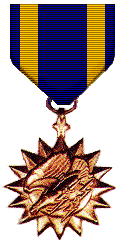 A few months ago the Star printed the unofficial news about Lieut. H. R. Burnett of Coldwater receiving an air medal. Now comes the official announcement from the Navy Department concerning the awarding of the medal:
A few months ago the Star printed the unofficial news about Lieut. H. R. Burnett of Coldwater receiving an air medal. Now comes the official announcement from the Navy Department concerning the awarding of the medal:
Kansas City, Mo., May 19, 1943: The Navy Department announced recently that the President of the United States takes pleasure in presenting the Air Medal to Lieutenant Junior Grade Howard R. Burnett, USNR, for service set forth in the following citation:
"For meritorious achievement while participating in aerial flight as pilot of a scout bomber, attached to a U. S. aircraft carrier, in combat against enemy Japanese naval forces in the battle for the Soloman Islands on November 14 and 15, 1942. In the face of heavy anti-aircraft fire and hostile fighter planes, Lieutenant (junior grade) Burnett participated in numerous attacks on major Japanese forces, scoring as direct heavy bomb hit on an enemy vessel. By his skill, courage, and aggressive fighting spirit he contributed in a large part to the success of our forces in that area."
Lieutenant Burnett is the son of Marjorie Burnette of Coldwater. He was born on June 5, 1916.
View a facsimile of the Air Medal Citation
The Western Star, August 18, 1944.
LT. H. R. BURNETT MISSING IN ACTION
One of Coldwater's Top Fliers Unaccounted For by Navy
The entire Coldwater and Wilmore communities were shocked last Saturday to learn that 28 year old Lieut. H. R. Burnett, son of Howard and Marjorie Burnett, was listed as missing in action. His mother received a telegram early Saturday morning stating that her son was missing in the operation of his naval duties. The date of his being missing was not revealed at this time, due to security reasons.
Mrs. Burnett's daughter, Miss Addie Burnett of Wichita, came to Coldwater Saturday afternoon to be with her mother but had returned to her work on Monday. Another son, Pfc. Burke Burnett, wrote his mother only recently for the first time in five or six weeks. He is in the Marshall Islands area, probably with a Navy task force.
On Monday of this week Mrs. Burnett received a letter from Lieut. Burnett, the envelope bearing the Navy postmark of July 31. The Letter follows:
Dearest Mother, Still O.K., feeling as young as ever. You would probably be surprised if I told you I was writing this letter while I am flying combat air patrol. I am sorry that I haven't a pen with me. Guess you will forgive me as long as I am writing. I don't have much to say only that I still like my work and would rather be here than there, when we have a big job to do. I haven't seen Burke yet and have no idea where he is. I hope he is getting to see some of the excitement. If a person goes in he likes to see some of it. It sure is pretty today, clouds are silver color, with the sun shining down on them so beautifully. I guess that isn't a very picturesque description. It is something to write about, anyway. Love, H. R.
"Redbird" as Lieut. Burnett was known by thousands of his admiring friends and buddies all over the Southwest and Central Pacific areas, has been known as one of the Navy's most courageous and most daring pilots. One of the first to win the Air Medal by knocking out alone several Japanese ships with his Douglas Dauntless dive bomber, he returned to the States about 15 months ago and asked to be transferred to a fighter squadron.
Hailed on the Ginny Simms program one evening last fall as a hero and one of the Navy's fightingest men, his devotion to his country and his earnest appeal to youthful pilots to help make the world decent and safe thrilled the millions of listeners.
His many friends join with his loved ones in the hope that word of his rescue will be announced soon.
Several weeks ago Lieut. (j. g.) Gerald Lott of Wilmore was flying his Navy fighter plane in the Southwest Pacific and he was returning to his ship when he switched to another short wave length to hear a voice say, "All right Redbird, what do we do next?" Lieut. Burnett, squadron leader of his fighter group, had evidently completed with his squadron another mission over their objective. (SB)
The Western Star, May 25, 1945.
LIEUT. H. R. BURNETT AWARDED GOLD STAR
Has Been Missing in Action Since August 4, 1944.
Ninth Naval District Branch Public Relations Office, Kansas City, Mo. Lieutenant Howard Reason Burnett, USNR, son of Mrs. Marjorie E. Burnett and Howard R. Burnett of Coldwater, Kans., has been awarded the Gold Star in lieu of the Second Air Medal. Lieutenant Burnett has been officially listed as missing in action since August 4, 1944. His award was for service as set forth in the following citation:
"For meritorious achievement while participating in aerial flight as Division Leader attached to a U. S. S. LEXINGTON Air Group assigned to strike against enemy Japanese installations and in support of landings on an island of the Marianas Group from July 18 to 21, and on other flights against the Palau Islands, July 25 to 27, 1944. Leading his division in repeated bombing and low level strafing attacks on hostile beach defenses of designated landing areas in the face of rain squalls and heavy anti-aircraft fire, Lieutenant Burnett contributed materially on our troop landings. On July 28 he led a bombing attack on an airstrip ar Palau which resulted in the destruction of four grounded enemy planes, and the next day flew in hazardously low through the formidable fire of a Japanese anti-aircraft installation and succeeded in putting it out of action. His cool courage and unflinching devotion to duty were in keeping with the highest traditions of the United States Naval Service." (signed)
M.A. MITSCHER,
Vice Admiral, U.S. Navy
View a facsimile of the original Gold Star Citation
View a facsimile of the original letter which accompanied the Gold Star Citation
The Western Star, January 23, 1946
LIEUT. H. R. BURNETT OFFICIALLY LISTED DEAD
Had a Brilliant Career As Navy Fighter Bomber Pilot.
Several weeks ago word was received here that Lieutenant Howard Reason Burnette, eldest son of Howard R. Burnett and Marjorie E. Burnett of Coldwater had been declared deceased by the Navy Department. His plane was hit by anti-aircraft fire and crashed in flames over Iwo Jima August 4, 1944, and he was listed as missing in action until confirmation of his death was issued by the Secretary of the Navy.
Howard Reason Burnett was born in the New Eden community in Comanche County, Kansas, June 5, 1916, and died August 4, 1944, at the age of 28 years, 1 month and 30 days. He attended the New Eden rural schools and was greatly interested in athletics there. Later he attended Coldwater High School, graduating in 1934. While in C. H. S. he was outstanding in football, track and basketball, as well as a good student. He later attended Kansas University three years and continued to be a good athlete and student.
While working for the Kansas Electric Power Co., at Lawrence, Kansas, he resigned a fine position to enlist on December 19, 1940, in the U. S. Naval Reserve for four years. On April 17, 1941, his enlistment terminated to accept an appointment as Aviation Cadet, and after passing all tests at Fairfax Field, Kansas City, reported to the Naval Air Station, Pensacola, Florida, for active duty undergoing training. On September 12 he reported to the N. A. S. at Miami, Fla., for further training. On November 15 he was commissioned an Ensign and was assigned to an Advanced Carrier Training Group, Pacific Fleet, San Diego, calif., for advanced training in flying.
Lieut., Burnett left the States in May, 1942, and made many strikes against the Japs before returning home in June, 1942. On July 6, 1943, H. R. reported to the N. A. S. at Seattle, Washington, having asked to be transferred to a Fighter Group. While at San Diego awaiting combat duty on an airplane carrier as the pilot of a Gruman Hellcat fighter plane. "Redbird" as he was known to thousands of admiring Navy men, was featured in a special interview on the N. B. C. His mother has a phonograph record which was made by the National Broadcasting Company and presented to her, being a recording of the interview.
Lieut. Burnett's military record as a Navy flier is a brilliant one. He was absolutely devoid of fear and as a squadron leader led his group in devastating raids on Jap shipping and installations at a time when our fliers had a minimum of protection because of lack of equipment.
From various communications received by Lieut. Burnett's father and mother, we print the following as a matter of record.
United States Pacific Fleet
Fighting Squadron Nineteen
15 August 1944
Dear Mrs. Burnett;
While the Navy Department will have told you that Howard's missing in action it will not tell you of the void left in this squadron nor the deep personal loss I feel. I only wish there were some chance of his return but any such hope is too remote to even be considered. His plane was seen to catch on fire in the midst of intense anti aircraft fire 4,000 feet over a Jap base within 600 miles of Tokyo, and it is believe to have crashed.
Redbird as we knew him, was one of the most colorful pilots in the war. He was an outstanding leader that the Navy and our country will sorely miss him. He is well known throughout the fleet for his general aggressive spirit, and in particular for his excellent work during the occupation of the Solomons. A recent citation for this work has just been received and is being forwarded to you.
The two pictures of you which were on his desk together with other very personal belongings, are being sent to you direct while his clothes and other belongings are being forwarded through the Navy Supply Department. The enclosed check represents his personal cash and his interest in the squadron and ships messes.
Please accept my heartfelt sympathy and write me if there is anything further that I can do or say.
Sincerely yours,
T. H. WINTERS, JR.
Commander, U. S. Navy.
Commanding Officer.
View a facsimile of the original letter
The Secretary of the Navy
Washington, 1 September 1945
Mrs. Marjorie E. Burnett
Coldwater, Kansas
My Dear Mrs. Burnett,
Your son, Lieutenant Howard Reason Burnett, United States Naval Reserve, has been carried on the official records of the Navy Department in the status of missing in action since 4 August 1944. He was the pilot of a plane which, together with other aircraft, left the carrier on a bombing and strafing mission against enemy aircraft, shipping and installations at Iwo Jima, Volcano Islands. During the attack over the target, your son's plane was hit by anti aircraft fire, burst into flames, went into a tight spin and crashed into enemy territory. Search operations were impossible due to the enemy activity on the island.
In view of the strong probability that your son lost his life when the plane in which he was flying was hit by enemy aircraft fire, burst into flames and crashed and because the incident was clearly observed and there were no indications that he might have survived, I am reluctantly forced to the conclusion that your son is deceased.
In compliance with Section 5 of Public Law 490, 77th Congress, as amended, the death of your son is, for the purposes of termination of pay and allowances, settlement of accounts, and payment of death gratuities, presumed to have occurred on 5 August 1945, which is the day following his expiration of twelve months in the missing status.
I extend my deepest sympathy to you in your sorrow. It is hoped that you may find comfort in the knowledge that your son gave his life for his country, upholding the highest traditions of the Navy.
Sincerely yours,
JAMES FORRESTAL
Citation:
In the name of the President of the United States, the Commander, Fast Carrier Task Forces, United States Pacific Fleet, presents the GOLD STAR in lieu of a second Air Medal to Lieutenant Howard Reason Burnett, United States Naval Reserve, for service as set forth in the following citation:
"For distinguishing himself by meritorious achievement while participating in aerial flights as division leader in a carrier based aircraft assigned to strikes against the enemy installations on an Island of the Marianas Group in support of landings on that island on 21 July 1944, and on other flights of actions against the Palau Islands between 25 and 27 July 1944. He led his division in repeated bombing and low level strafing attacks on the beach defenses where our troops were to land, helping materially to reduce initial losses in these landings. This support was conducted in heavy rain squalls which together with anti aircraft fire would have interfered with a less determined leader. On 26 July 1944 he led his division in a bombing attack on grounded enemy planes at an air strip at Palau Islands. After dropping his bomb he made repeated low level strafing attacks on planes, participating in the destruction of approximately four aircraft. Two planes of his division including his own were hit by anti aircraft fire during these attacks. The next day he pressed home an attack on an anti aircraft installation which he put out of action from extremely low altitude while firing at him. His coolness, skill and courage were at all times in keeping with the highest tradition of the United States Naval Service."
M. A. MITSCHER
Vice Admiral, U. S. Navy
View a facsimile of the original Gold Star Citation
Combat Record of Lieutenant H. R. Burnett, A-V (N), USNR
This officer's first combat experience was the morning of August 7, 1942, when we took Guadalcanal. Taking off from the Enterprise before dawn in an SBD loaded for an enemy objective, coastal guns, ships, etc., he attempted to rendezvous, but the night was very dark and cloudy so this proved impossible. Several others had the same trouble, so individually they flew to Tulagi, which was to be the squadron's dawn objective. Not finding the squadron and still alone he dove on a large coastal gun through anti aircraft fire and made several strafing runs with effective results, the coastal gun having been blown up. Returning to the carrier he rejoined his squadron and spent the rest of the day bombing the island in support of landing operations. Among other things a fuel dump and various buildings were blown up, as well as nullifying Jap resistance, Kolembangara and Gavuto were likewise attacked.
Next combat was in the battle of the Stewart Islands on August 24. Flying anti sub patrol from the carrier, Burnett returned to find enemy dive bombers attacking. Flying out to keep away from our own anti aircraft, and to get a crack at the bombers, he intercepted them and had several dogfights, shortly downing one Val with his fixed guns. The carrier had been hit by three bombs and the flight deck was smoking from the fires below with three bomb holes through it. Although returning nearly out of gas he was forced to circle while the deck was being patched, and finally landed with gas enough for about ten minutes of flying left. A number of planes had to land in the water out of gas.
Next came the Battle of Santa Cruz on August 26. Having been informed that there were several carriers in the vicinity, Burnett was sent on a 200 mile search at dawn. Sighting the ships that had been shelling Guadalcanal during the night, two battleships, three heavy cruisers, two light cruisers and seven destroyers, he flew about fifty feet over the water about two miles from the force until it was definitely established as enemy. A report of the enemy was sent in by radio and Burnett and his wing man, who were alone, tracked for about an hour, when they climbed to 14,000 feet, as they had not seen the carriers. While diving on one of the cruisers the wing man was thrown into a spin and forced to return to the carrier. Burnett dropped his bomb and an hour later another pilot reported the stern of the cruiser in flames.
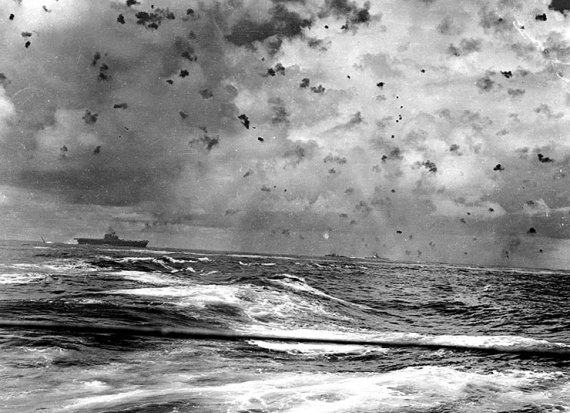
The USS Enterprise in action during the Battle of Santa Cruz Islands, 26 Oct 1942.
U.S. Navy ships firing at attacking Japanese carrier aircraft during the battle, 26 October 1942. USS Enterprise (CV-6) is at left, with at least two enemy planes visible overhead. In the right center is USS South Dakota, firing her starboard 5"/38 secondary battery, as marked by the bright flash amidships.
Source: http://www.history.navy.mil/photos/sh-usn/usnsh-e/cv6-a.htm
Returning the carrier was found under attack, Burnett's attention being attracted by a Jap plane burning on the water. The sky was covered by black smoke from five inch anti aircraft fire. Seeing a burst of flame on the Hornet, he was soon in the midst of enemy planes, and several dog fights. One plane got on his tail and shot out his hydraulic system, one cylinder in the engine and the cockpit was filled with holes. His gas system had been punctured so that there was eight inches of gas in the cockpit. However, seeing an enemy twin engine torpedo plane fifty feet off the water, made a pass and shot it down. The crew got into its rubber boat and Burnett's rear seat man strafed them, deflating the boat. He had just enough gas to get back on the carrier, and was aboard for two hours of continuous bombing by the enemy.
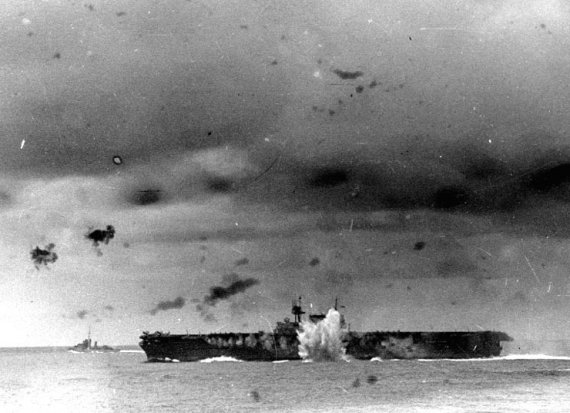
Bomb Hits Near USS Enterprise During Battle of Santa Cruz Islands
A Japanese bomb explodes off the port side of USS Enterprise (CV-6) during the action, 26 October 1942.
Source: http://www.history.navy.mil/photos/sh-usn/usnsh-e/cv6-a.htm
The defense of Guadalcanal on November 14 and 15 came next, when the squadron attacked surface shipping which was trying to retake the island. While bombing a number of ships through heavy anti aircraft fire, Burnett and his wing man were credited with a direct hit on a heavy cruiser, which sunk, and a near miss on a transport loaded with troops. The cruiser was dead in the water and exploding, with the stern low in the water, when they left.
Lieutenant Burnette has been awarded the Air Medal.
Awards and Medals:
Air Medal, Gold Star in lieu of second Air Medal, Presidential Unit Citation (U. S. S. Enterprise), Presidential Unit Citation (1st Marine Division, Reinforced), Purple Heart, American Defense Service Medal and Asiatic-Pacific Area Campaign Medal. (SB)
The Western Star, March 21, 1947.
Coldwater Fliers Given Navy Citations
Ninth Naval District, Great Lakes, Ill. - Lieut. Howard Reason Burnette, of Coldwater, Kans., son of Mrs. Marjorie E. Burnette Crowe and Howard Burnette, has received posthumously the permanent citation for his Silver Star Medal from Secretary of the Navy James Forrestal, for the President.
Lieut. Burnette, earned the award in aerial flight during action against enemy forces in the Battle of Santa Cruz.
During the war, citations were temporary, or incomplete for security reasons.
Text of the complete citation is as follows:
"For conspicuous gallantry and intrepidity as pilot of a plane in a squadron attached to the USS Enterprise, during operations against enemy Japanese forces in the Battle of Santa Cruz, on October 26, 1944. Leading an offensive search flight to the position of an enemy task force consisting of capital ships and screening vessels. Lieut. Burnette delivered a successful attack, in the face of severe enemy antiaircraft fire, to inflict heavy damage on an enemy heavy cruiser. Returning his damaged plane to the carrier base, he attacked and destroyed a Japanese torpedo bomber as it attacked the USS Hornet. His courage and devotion to duty were in keeping with the highest traditions of the United States Naval Service."
--------------------
(The other pilot mentioned in the above article was Lieut. Clifford E. Case, USNR, of Coldwater, Kans., who received a permanent citation for his Air Medal.)
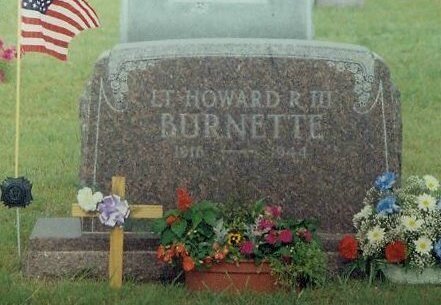
LT. HOWARD R. BURNETTE III
1916 - 1944
Memorial stone, front view, Crown Hill Cemetery, Comanche County, Kansas.
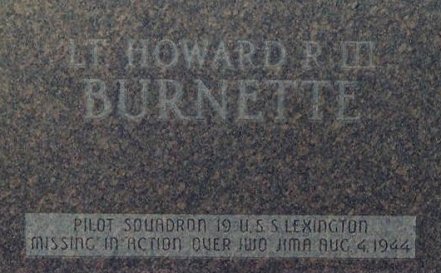
LT. HOWARD R. BURNETTE III
PILOT, SQUADRON 19, U.S.S. LEXINGTON
MISSING IN ACTION OVER IWO JIMA AUG 4, 1944.
Memorial stone, back view, Crown Hill Cemetery, Comanche County, Kansas.
The following www.digits.com "hits counter" started counting on 8 Nov 2007.

Return to HOME
The above news articles were transcribed for this site by Shirley Brier. Thanks to Bobbi Huck for the photos of the memorial stone. This web page was created by Jerry Ferrin on 28 June 2003; it was last updated 8 Nov 2007.
|


